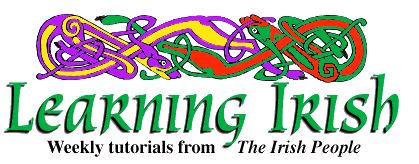
Irish Lesson 24
| Pronunciation Review We now review the consonants "t" and "d". These are related in both English and Irish, because a "d" is pronounced like a "t" except for use of the vocal cords. In Irish, each of these two letters has a broad sound when the nearest vowel in the word is "a, o, u", and a slender sound when the nearest vowel is "e, i". For the broad sound, place the tongue front up against or close to the roof of the mouth, behind the upper front teeth and touching the back of them. Then say the "t" or "d" sound. Examples: Tá, tóg, tú, tusa (TU-suh), tamall (TAH-muhl), tosaigh (TUH-see), tús (toos). Dá, dó, dún (doon), dara (DUH-ruh), doras (DUH-ruhs), duine (DIN-e), duibheagán (DIV-uh-gaw*n). Notice that in "duine" and "duibheagán", the "u" following the "d" tells you to give the "d" its broad sound, even though the next actual vowel sound is for the "i". A few more examples: trá, trom (truhm), trua (TROO-uh), drad (drahd), dlú (dloo), droch (druhk*). For the slender "t" and "d", touch the tip of the tongue against the hard ridge behind the upper front teeth. The tongue can be inclined forward and even touch the back of the upper front teeth. The pronounce the "t" or "d". The sound will have a trace of a "y" sound at the end of it. Try: Te(te), tine (TIN-e), tír (teer), teach (tyahk*), trí (tree). Déan (day*n), dian (DEE-uhn), deas (das), dearg (DYAR-uhg), díol (DEE-uhl), dlí (dlee). In some Irish speech, the traces of the "y" sound may be changed so that a slender "t" sounds like an English "ch", and a slender "d" like an English "j". "Tine" may sound like (CHIN-e), and "deas" may sound like (jas). In our pronunciation guide, we sometimes put a (y) in to familiarize you with this feature of Irish. From now on, you must watch to see whether an "a, o, u" or "e, i" is nearest the "t" or "d", so that you can give the "t" or "d" its proper sound. Vocabulary Masculine nouns leanbh ((LAN-uhv), child airgead, an t-airgead (AR-i-guhd, un TAR-i-guhd), money baile (BAHL-e), town, home ceacht (kyahk*t), lesson cara (KAH-ruh), friend spota (SPOH-tuh), spot Feminine nouns síleáil, an tsíleáil (SHEE-aw*-il, un TEE-aw*-il), ceiling, the ceiling cnámh, un chnámh (kuh-NAW*V, un k*uh-NAW*V), bone, the bone Smig, an smig (smig), chin
geal (gal), bright breá (bir-RAW*), fine deas (das), nice, pretty
Drill For practice with "is", do the following drill until you can repeat the groups without hesitation. Céard é seo? (kay*rd ay* shuh), What is this? Is leabhar é (is LOU-whur ay*). An leabhar Gaeilge é? (GAY*-lig-e), Is it an Irish book? Ní hea, ach leabhar Béarla (nee ha, ahk* LOU-wuhr BAY*R-luh). It is not; it is an English book.
Céard é sin? Nach baile é? (nahk* BAHL-e ay*) Sea, ach ní baile deas é (sha, ahk* nee BAHL-e das ay*).
An fear mór é? Ní hea, ach fear beag (byuhg).
Nach cailín deas í sin? Sea, agus cailín galánta freisin (guh-LAW*N-tuh FRESH-in), Yes, and a fashionable girl, too.
Cé tusa? (kay* TU-suh), Who are you? Is mise Séan Ó Rian (is MISH-e shaw*n oh REEN), I am John Reen.
Cé mise? (kay* MISH-e), Who am I? Is tusa an fear eile (EL-e).
Cé sinne? (kay* SHIN-ye), Who are we? Is sibhse na múinteoirí (is SHIV-she nuh moo-in-TYOHR-ee), You are the teachers.
Cé hé sin? Who is that? Is é sin Liam (shay* shin LEE-uhm), That's William.
Agus cé hiad seo? (AH-guhs kay* HEE-uhd shuh) And who are these? Is iad seo Máire agus Séamas (SHEE-uhd shuh MAW*-re AH-guhs SHAY*-muhs), These are Mary and James.
Cé hé an fear ag an doras? (kay* hay* un far eg un DUHR-uhs) Who is the man at the door? Is é Brian é (shay* BREE-uhn ay*), It's Brian. Cé hí an cailín leis? (kay* hee un kah-LEEN lesh) Who is the girl with him? Is í Brid í (shee breed ee), It's Bridget.
Conversation Seán (shaw*n); Táimid ag baile arís (TAW*-mid eg BAHL-e uh-REESH). We're home again. Máire (MAW*-re): Táimid, tar éis bheith in Éirinn trí mhí (tuhr ay*sh ve in AY*R-in tree vee). We are, after being in Ireland three months. Seán: Céard é sin ar an tsíleáil? (kay*rd ay* sin er un TEEL-aw*-il) What's that on the ceiling? Máire: Spota uisce, go cinnte (SPOH-tuh ISH-ke, goh KIN-te). A water spot, for sure. Seán: Tá piopa briste thuas an staighre, is dócha (taw* PEEP-uh BRISH-te HOO-uhs un STEYE-ruh, is DOHK*-uh). There's a pipe broken upstairs, probably. (c) 1997 The Irish People. May be reprinted with credit. |
Return to Return to The Summerlands Public Library Home Page